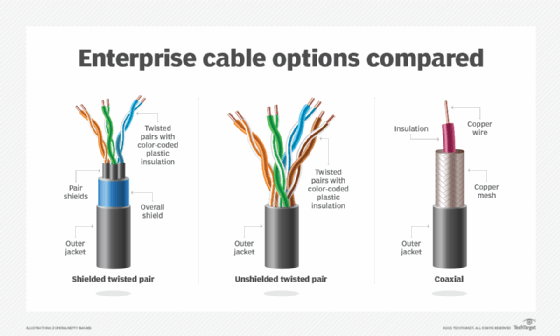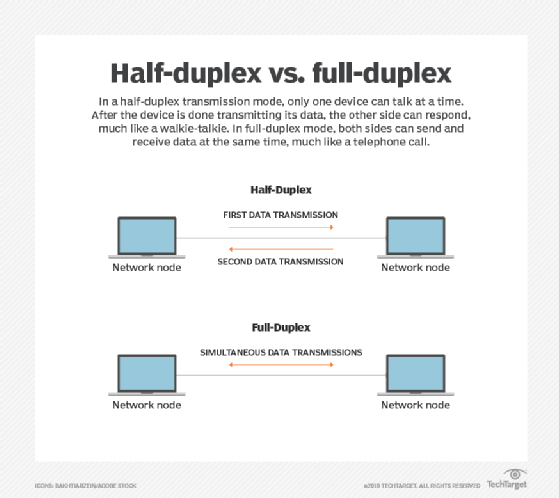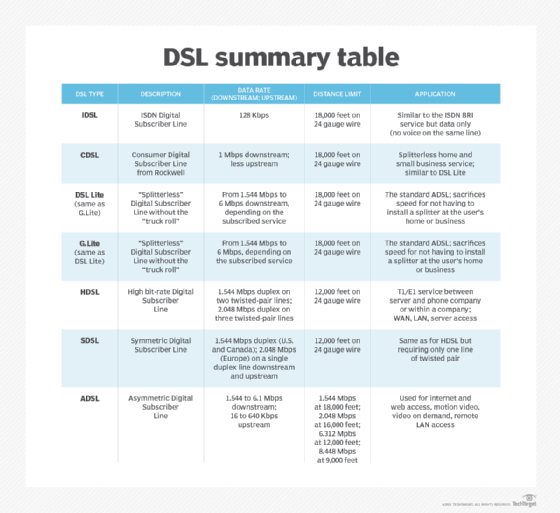IDSL
What is IDSL?
IDSL is a hybrid of a digital subscriber line (DSL) and integrated services digital network (ISDN) technology that transmits data slightly faster than ISDN but much slower than most DSL services.
IDSL is an acronym for an ISDN digital subscriber line. It leverages ordinary twisted-pair copper telephone lines to transmit data from a user to a destination using digital (rather than analog or voice) transmissions. This approach helps bypass the telephone company's central office equipment that handles analog signals.
What is the IDSL transfer rate?
The standard transfer rate for IDSL is approximately 128 kilobits per second (kbps) or 144 kbps on unshielded twisted pair local loops that can be as long as 18,000 feet. In this scenario, two bonded 64-kbps bearer channels provide a 128-kbps channel that bonds with the 16-kbps data channel to achieve 144 kbps.
ISDN, on the other hand, is slightly faster, running at 144 kbps or 192 kbps. However, IDSL circuits usually carry data and not voice. IDSL only operates at a local level to deliver "always-on" internet access. In contrast, ISDN is a circuit-switched network service used for data, fax, multimedia, voice and video.
There are primary advantages of adopting IDSL rather than ISDN:
- always-on connections;
- elimination of call setup delays;
- elimination of per-minute fees;
- flat-rate billing; and
- seamless transmission of data over a data network (instead of public switched telephone network).
Like ISDN, IDSL supplies a full-duplex of data at 128 kbps through a single-wire pair. IDSL, like ISDN, also uses a 2B1Q line code scheme to allow transparent operation through the ISDN U interface. Users can also leverage existing CPE hardware like bridges, ISDN BRI (basic rate interface) terminal adapters and routers to make connections.
The only disadvantage of IDSL is that it demands its own telephone line to enable IDSL service. This means customers need two telephone lines to ensure they can dedicate one line for phone services. As a result, it is more expensive than ISDN.

IDSL vs. ISDN
The most significant difference between IDSL and ISDN is the carrier. This is because IDSL cannot connect through a voice switch, but ISDN can. They both use the same technology, but IDSL routes the signal through different equipment. For example, IDSL uses DSL-type equipment, and ISDN uses standard switching equipment.
In this case, data communication technology will terminate the IDSL connection and push it to a data switch or router. This is a critical feature, as telecommunications operators have problems with the overloading of central office voice switches.
Key differences between IDSL and ISDN are as follows:
- ISDN passes through the phone company's central office voice network; IDSL bypasses it by plugging into a particular router at the phone company.
- ISDN requires call setup; IDSL is a dedicated service.
- ISDN may involve per-call fees; IDSL is a flat rate service with no usage charges.
Customers with only an IDSL connection will not have access to voice services or ISDN signaling. This is ideal for internet service providers (ISPs) who are not required to provide public voice services. IDSL then becomes a viable alternative way of leveraging Plain Old Telephone Service dial-up to offer higher-speed internet access in rural environments.

History of IDSL
Ascend Communications (now part of Lucent Technologies) developed IDSL decades ago. IDSL is only one possible technology in the DSL approach. The most popular of these technologies is the asymmetric digital subscriber line (ADSL). This approach enables the use of existing ISDN card technology for data-only use.
Although IDSL has been around for a long time, it is not available in all countries. IDSL is not cost-effective but it is worthwhile for businesses and individuals who require fast internet access but do not have access to DSL. IDSL is virtually nonexistent in the United States and never managed to take off in North America.
When it comes to bandwidth, as IDSL is often unfavorably compared to ADSL and other DSL technologies, the low numbers of adoption seen now will likely disappear.

Unlike DSL, distances do not limit IDSL. For example, for DSL subscribers, the client must reside within 18,000 wire-feet (5,486 wire-meters) from the communications hub. Whenever an individual or business is located on the outer limits of this range, the maximum speeds achieved by the DSL connection will be slow, and the signal quality will be poor. So, for DSL connections, it is always better to be closer to the hub for better service.
IDSL, on the other hand, does not have such limitations, so customers residing farther away can also enjoy an always-on connection.







